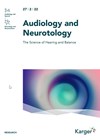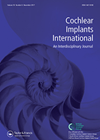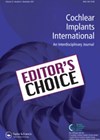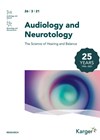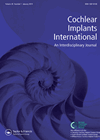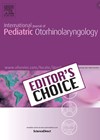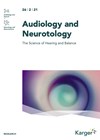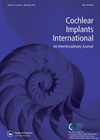
Journal Reviews
Cochlear implants in the over 80s
The UK has an ageing population. Seven percent of the over 80s population have bilateral severe to profound hearing loss which can lead to associated negative outcomes (social isolation, depression and reduced quality of life). Cochlear implantation (CI) can successfully...
Impedance for different electrode types
Measuring cochlear implant (CI) electrode impedances is common in CI programming appointments to measure the integrity of the implant e.g. whether there are any open or short electrodes. This is because impedance measures the flow of current between intra and...
Moving towards implanting children below 12 months of age
Newborn hearing screening has ensured that deaf infants are identified soon after birth so that habilitation can begin as early as possible. Cochlear implantation is a key component of early intervention for some children, but it is often not performed...
Cochlear implantation in asymmetric hearing loss
Criteria for cochlear implantation (CI) is a constant topic of debate. The UK traditionally had relatively restrictive guidance, although this has been greatly improved by more recent guidance released in 2019. Nevertheless, because of the lack of evidence for cost-effectiveness,...
Robotic insertion of electrode array in cochlear implantation
Cochlear implants (CIs) are commonly used for profound bilateral hearing loss. They have specific national guidance for their insertion, however patients with a substantial residual acoustic hearing are potential CI candidates. Preservation of this residual hearing can be sought with...
Cochlear implantation following radiotherapy treatment of vestibular schwannomas
The authors presented a case report and systematic review assessing the outcomes of patients from cochlear implantation (CI) following radiotherapy treatment for vestibular schwannoma (VS). Outcomes of cochlear implantation in these patients are uncertain due to the combination of both...
Semicircular canal dehiscence and cochlear implantation
Semicircular canal dehiscence (SCD) is thought to occur in 3% of the population, it is mostly asymptomatic, but patients may present with sound-induced vestibular symptoms, low-frequency conductive hearing loss, autophony, hyperacusis and aural fulness. With the increasing utilisation of cochlear...
The impact of bilateral implantation on language outcomes
An American study retrospectively looked at the language outcomes of 204 children implanted either bilaterally, sequentially or unilaterally. All children received their first implant before the age of three years, and language measures were collected when the children were aged...
Can we centralise cochlear implant surgery and keep most appointments close to home?
The NHS Five Year Forward View promoted seeing patients closer to home in order to provide better care, cut down on missed appointments and reduce costs. This encouraged the development of ‘hub and spoke’ models of care, but this model...
Quality of life after cochlear implantation in the older population
Cochlear implants (CI) have been increasingly adopted in older adults with severe to profound hearing loss as a result of the growing and ageing world population. There is much interest in the cost-effectiveness and quality of life in CI users....
Recording of electrode voltages (REVS) to determine extra-cochlear electrodes
Determining whether electrodes are sitting within the cochlea can be difficult as the checks run by the programming software cannot always determine this. In some cases, patients may be unable to give the audiologist detailed feedback which can complicate the...
Cobalt hip implants and auditory-vestibular outcome
Cobalt-chromium (Co-Cr), metal-to-metal hip implants were commonly used until several side-effects were reported due to an increased level of Co and Cr metal ions in patients’ blood. Although this type of hip replacement was almost completely abandoned, there are still...

